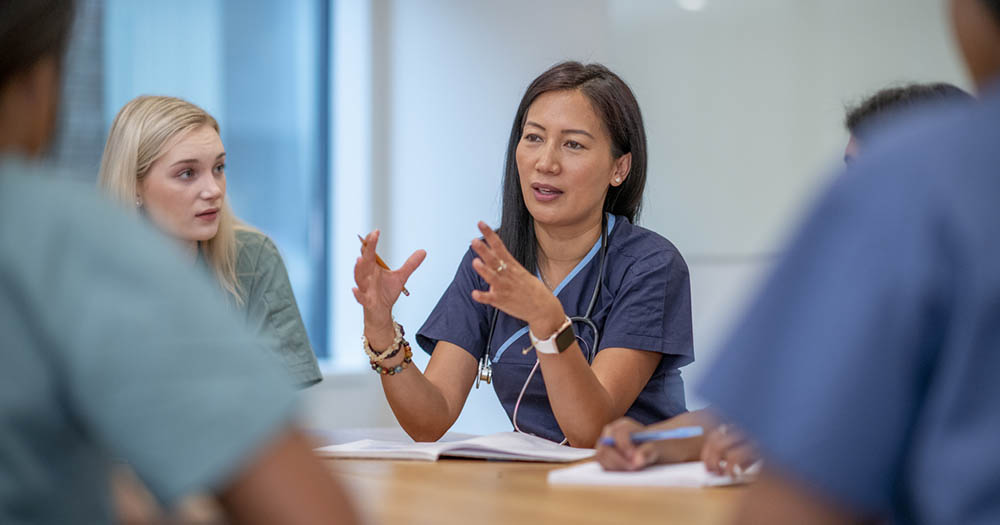Standard 8 of the National Service Framework (NSF) for diabetes advocates ‘good quality consistent care is provided for people with diabetes whenever they are admitted to hospital’ (Department of Health [DoH], 2001).
People with diabetes are admitted to hospital twice as often as people without diabetes and they stay for twice as long (DoH, 2001). Their experiences of inpatient care are often poor. Many people with diabetes complain of inadequate knowledge among hospital and ward staff, lack of information available and delays in discharge relating to their diabetes, often when diabetes was not the reason for admission (Audit Commission, 2000). The NSF recommends employment of diabetes specialist nurses to oversee the care and management of people with diabetes while in hospital. As the specialist nurse cannot be in all places all of the time, education of ward and hospital staff is essential. In order to be effective, any education must result in improved care and practice.
Diabetes update courses for staff
Running diabetes update courses for staff within the hospital should go some way towards meeting the educational needs of people with diabetes during hospital admission. Alterations in knowledge, skills and attitudes, however, do not necessarily mean changes in practice. The evaluation of nurse education programmes usually consists of the immediate assessment of changes in knowledge and attitudes (Ferrell,1988). Rarely do they focus on changes in the nurse’s behaviour, or consequent improvements in patient care. Attendance at a course does not ensure that nurses will change their practice on return to their clinical setting. However, it is difficult to assess the application of knowledge into practice, and, for this reason, it is usually omitted from course evaluation.
Bridging the theory-practice gap
The theory-practice gap has always existed and is widely discussed in the nursing press (Allmark, 1995; Yassin, 1994; Varcoe and Cresswell, 1993). Yassin (1994) suggests that there are two main problems causing the theory-practice gap. First, some of the theory is too idealistic and impractical. Second, even where the theory is practical and beneficial to patients, some nurses do not act on it, possibly due to ignorance or the rigid system in which they work or because they choose to ignore it. This is supported by Draper (1991), who also suggests there are two types of theory: the realistic, the purpose of which is to account for the complex reality of nursing; and the idealistic, which describes an idealised world of nursing as it ought to be.
There are suggestions on how the theory practice gap can be bridged. Making a Difference (DoH, 1999) acknowledged the gap and put down proposals for narrowing it; in particular strengthening the role of the lecturer practitioner, but this is more in relation to pre-registration nurses than post-registration. Backhouse and Brown (2000) used a patient questionnaire to try and close the theory-practice gap within their area. This resulted in a nurse-led programme of managed change. Reflexive action research and reflective practice are also considered an appropriate formula for addressing the gaps and can be used in both pre- and post-registration education (Freshwater, 2000).
Most of the evidence relating to theory and practice has focused upon manipulating factors in the environment in which learning takes place, but maybe we should also be manipulating the environments in which practice takes place. This is supported by Yassin (1994) and Brocklehurst (1999) who argue for fostering a climate in which all nurses feel encouraged to challenge accepted theory and develop alternatives of their own.
Measuring change
Measuring any change in practice is also difficult. Scheller (1993) highlights three problems when attempting to measure the impact of continuing professional education on practice. These are:
- the difficulty of measuring the impact of continuing professional education on nursing practice and the quality of care
- the lack of consensus as to what constitutes use of nursing knowledge
- the use of knowledge gained from continuing professional education programmes is influenced by many different factors that interact to affect nursing practice.
Any tool used to measure change needs to address these issues if it is to truly identify what happens to knowledge and how practice and quality of care is affected. Many studies, including this one, examine the knowledge gained and the changes in practice but have shied away from the more intricate processes in between.
Application of knowledge
There are several theories on how knowledge is eventually turned into a change in behaviour. Cervero (1985) suggests that a change in behaviour is affected by four sets of independent variables. These are:
- the education programme
- the individual learner
- the proposed behaviour change
- the social system within which the individual operates.
Rogers (1983) describes a process he believes an individual will go through before choosing whether to adopt or reject a change in practice. This is termed the Innovation-Decision Process Model and has four stages:
- Knowledge: The individual is exposed to the information or an innovation and gains some understanding.
- Persuasion: The individual forms a favourable or unfavourable attitude toward the information/innovation.
- Decision: The individual engages in activities that lead to a choice to adopt or reject the information or innovation.
- Confirmation: The individual seeks reinforcement for the decision made.
Learning related to clinical practice could be defined as a decision to adopt an innovation (Rogers, 1983). Rogers (1983, p169) explains that in the knowledge stage many people who know about an innovation may not adopt the concept because they do ‘not regard it as relevant to their situation, as potentially useful’. During the persuasion stage, these individuals ‘become more psychologically involved with the innovation’. They begin to pursue information to learn as much as they can about the idea. This is important, since the way an idea is presented may or may not give a lasting impression that will follow the individuals throughout their decision process.
Learning related to clinical practice could be defined as a decision to adopt an innovation. This would help healthcare professionals and education providers understand further why nurses’ practice may not be changed or influenced after education offerings. This approach would allow a study of ‘What happens to learning?’ to focus on the transitional process from decision to confirmation within the Innovation-Decision Process Model. This model was used in this study and evaluated on knowledge and decision to adopt strategies, by assessing knowledge and practice changes.
Method
Two groups of registered nurses, all female, attended, at their request, the diabetes update course, which was based on realistic theory and run by the hospital’s diabetes specialist nurse on site. Two courses ran six months apart and both courses were attended by 23 nurses.
The course consisted of three full days – one day per week for three weeks. To be included in the study, the nurses had to attend all three sessions.
Attendees were asked to complete a pre-course multiple choice questionnaire (MCQ), which covered all teaching sessions and objectives. This questionnaire was not evaluated prior to its use in this study. At the end of the course the MCQ was completed again, along with a traditional course evaluation form and the knowledge gained over the three days was compared with pre-course results. All responses were anonymous. The knowledge of the course attendees was reassessed with the same MCQ used to determine prior and post course knowledge after 12 months for Group 1 (the attendees of the first course), and six months for Group 2 (the attendees of the second course). This was to measure retained knowledge and was compared to the pre-course MCQ results for each group.
Along with this final MCQ, the attendees were asked to complete an open-ended questionnaire, i.e. one that contained open questions rather than MCQ or ‘yes/no’ replies. This gave them the opportunity to reflect on what they had learned and how they had used the increased knowledge to change or improve their practice. This final evaluation asked the nurses:
- How was the course useful in relation to their nursing practice?
- What changes or improvements in practice, if any, did the course lead to?
- Were there any areas of practice you would have liked to develop but for some reason you were unable to?
Data analysis
Multiple choice questionnaire results
The pre-course MCQ results for Group 1 were compared to their 12-month results. The results for Group 2 pre-course MCQ were compared with their six-month MCQ results.
Wilcoxon matched-pairs signed ranks test and T-test were used to assess statistical significance. The knowledge gain immediately post course was significant in both groups (p<0.05, see Table 1). The knowledge assessments at 12 months in Group 1 and six months in Group 2 also showed a significant gain in knowledge compared to the pre-course results, indicating retention of knowledge over the afore mentioned time scales (see Table 1).
Change in practice evaluation
Each change in practice evaluation form was analysed and nurse responses were listed in the following categories:
- disease management
- education of patients
- practical skills.
Most nurses offered two or three responses per question, but many of these appeared to fit into one category rather than multiple categories. Most responses were related to improved practice (see Table 2). All nurses changed their practice in some way due to the increased knowledge. This ranged from checking quality controls had been carried out prior to blood glucose monitoring to taking a more active role in inpatient education.
Increased confidence brought about by the knowledge gained was cited as the main reason for changing practice, and this was also noted in Brown et al’s 1987 study, where the most frequently given reason for a lack of behavioural change was lack of confidence. Increased confidence is well recognised as a key to empowerment and change, and has been an identified outcome leading to change in many studies (Chavannes, 2002; Wilkinson et al, 2003; Hubley, 2002; O’Farrell et al, 2000).
Changes in practice were identified by the course attendees. The changes were assessed by the supervisors (the ward managers) as to whether the changes in practice were at an individual level or whether the nurses attending the course had also influenced the practice of others. On each occasion the ward manager documented any changes that they had seen. An interview between the supervisor and the course attendee was also documented. Changes in practice were discussed and the course attendee provided evidence of changes in practice – documentation, developments they have started, information they have sought, etc.
On discussion with work supervisors, all changes appeared to be at an individual level, and not at ward or department level, i.e. the change was seen in those who attended the course only and not in their co-workers. This could be a result of poor cascading of information by course attendees, or poor uptake/adoption by the co-workers.
Conclusion
There was a significant increase in knowledge and knowledge retention in both groups using the MCQ for assessment. Analysis of the change in practice questionnaire showed a number of improvements in nursing practice, increased nurse empowerment and quality of care through greater understanding at an individual level. These changes were related to the increased confidence of the nurses who had attended the course. Course attendees are always encouraged to share their knowledge with colleagues and cascade information across their ward team. There are no plans at present to study this further, however.
It is difficult to prove conclusively that continuing education programmes have direct bearing on the quality of care delivered to patients. Increasing personal confidence, however, is key in implementing change, and education in this instance did increase nurse confidence. It seems from this study and others (Brown et al, 1987; Peden, 1990; Francke, 1995) that themes emerge relating to the development of personal qualities that then can be applied to changes in practice and care delivery.





Key scientific developments presented at the conference.
6 Aug 2025